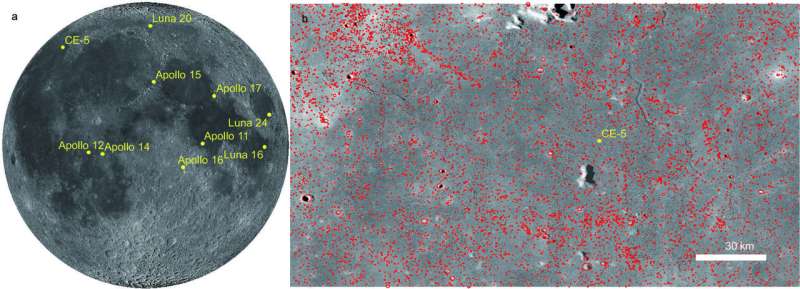China's moon sample updates lunar chronology model

Researchers led by professor Yue Zongyu and professor Di Kaichang from the Aerospace Information Research Institute (AIR) of the Chinese Academy of Sciences (CAS) and their collaborators have established an updated lunar chronology model that provides a more accurate timescale not just for lunar history but also for the evolution of planetary bodies in the inner solar system.
The research is based on the radiometric age of new samples collected by China's Chang'E-5 from the Moon along with crater counting in the landing area.
The study was published in Nature Astronomy on Feb. 14.
In lunar and planetary studies, it is essential to determine the age of important geologic units and events. Previous lunar samples were collected from the Moon by the Apollo and Luna missions between 1969 and 1976. Their ages were radiometrically measured as older than three billion and younger than one billion years old, which represent the real ages of the geologic units where the samples were situated.
These samples provided the basis for establishing the crater counting method whereby the age of unsampled lunar regions could be deduced from known sample information and the crater statistics of specific geologic units.
Unfortunately, the gap in age of 2 billion years between the samples represents almost half of lunar geologic history, thus making this chronology model questionable.
Since the previous samples mostly cover those older regions, one of the scientific objectives of the Chang'E-5 mission was to search the lunar surface for younger samples (i.e., about 2 billion years old) in order to verify and refine the lunar chronology model.
In December 2020, China's Chang'E-5 landed on the Northern Oceanus Procellarum, or "Ocean of Storms," near Rümker Mountain and Rima Sharp. The age of the returned samples was radiometrically measured at 2.03 billion years, which is highly consistent with expectations.
The research team subsequently made a detailed statistical analysis of the crater using high-resolution remote-sensing images of the Chang'E-5 landing area. They then obtained the scaled crater size-frequency, i.e., N(1), of the landing area through the production function. The N(1) value and the age of the Chang'E-5 samples thus formed a new control point for updating the Neukum (1983) chronology function through a nonlinear least-squares fitting algorithm.
Compared with the old chronology function, the new chronology function gives older ages in most cases, with a maximum difference of about 200 million years. Due to addition of the critical data point from Chang'E-5, the accuracy of the new chronology function is better than the classical Neukum (1983) model and should be used in lunar geologic unit dating in the future. As such, the Chang'E-5 samples serve as a "golden spike" by making a unique contribution to refining the lunar chronology function.
This new function, as a more accurate timescale, will also play an important role in lunar and planetary studies by making it possible to deduce new chronology models for Mars, Mercury, and other solid bodies in the inner solar system.
More information: Zongyu Yue et al, Updated lunar cratering chronology model with the radiometric age of Chang'e-5 samples, Nature Astronomy (2022). DOI: 10.1038/s41550-022-01604-3
Journal information: Nature Astronomy
Provided by Chinese Academy of Sciences





















